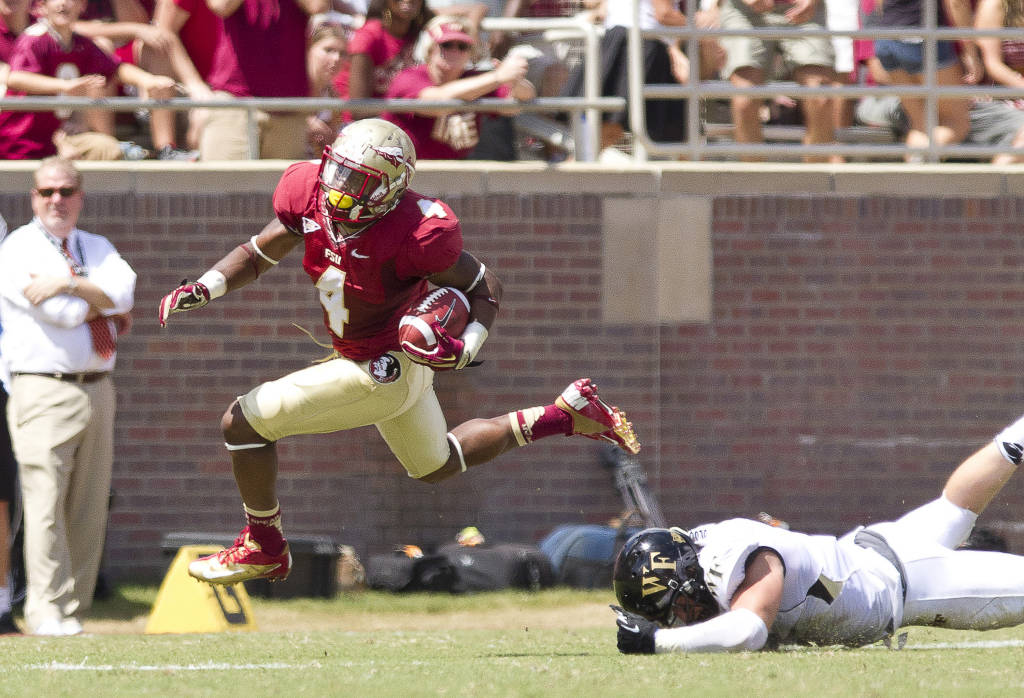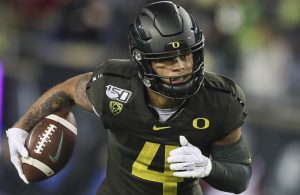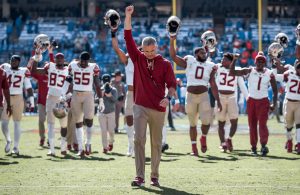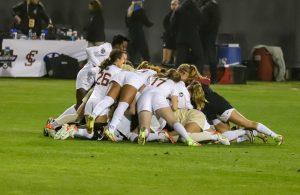- Sunday Seminole Summary: FSU Football Adds Pair of WR Transfers
- Sunday Seminole Summary: FSU Football Exits ESD With Top-15 Class
- Sunday Seminole Summary: FSU Soccer Tops BYU for Third National Championship
- Sunday Seminole Summary: FSU Soccer Advances to National Championship Match
- Seminole Sunday Summary: FSU Soccer Heads Back to College Cup
- Seminole Sunday Summary: FSU Soccer Reaches Sweet 16; Football Tops Boston College
- Seminole Sunday Summary: FSU Soccer Wins ACC, Advances to Second Round of NCAA Tournament; FSU Football Rallies Past Miami
- Seminole Sunday Summary: FSU Soccer Tops Wake on OT to Advance to ACC Final
- Seminole Sunday Summary: FSU Football Crushes UMass for Third Straight Win
- Seminole Sunday Summary: FSU Soccer Stays Perfect with Pair of Wins
What Could’ve Been: Notable FSU Players Who Had Careers Derailed by Injury
- By Clint Eiland
- Updated: July 2, 2017
 Ross Obley/FSU athletics
Ross Obley/FSU athleticsInjuries are an unfortunate part of football that cannot be escaped. The best teams and the worst teams are subject to them, and sometimes they can even dictate which category a team falls under. Florida State is no exception.
With all the Seminole greats that have come through the program, there are also those whose full potential never came to fruition. They were players who flashed the potential for greatness, but due to dumb injury luck, they never got to live up to their billing. The best that never were.
We’ve listed some of the more notable ones below and elaborated on their stunted careers at Florida State. Some were able to achieve NFL notoriety. Others were out of the game of football forever. Either way, these are the players who could’ve been some of the greatest to ever wear the Seminoles uniform, but fate just did not agree:
Chris Thompson, RB (2009-2012)
Despite playing in 39 games from 2009-12, running back Chris Thompson only ever played one full season for the Seminoles. But that one full season in 2010 gave fans something to be hyped about. With 845 yards rushing, 155 yards receiving, and seven total touchdowns, Thompson looked like a prime candidate for a breakout junior season.
But just five games into the 2011 season, he suffered a back injury and was sidelined for the year. In spite of all these setbacks, Thompson had a ferocious start to the 2012 season. In the first eight games, he ran for 687 yards on 7.5 yards per carry, and added 248 yards receiving. But once again injury struck, as he sustained a season-ending knee injury at Miami in November. He was well on his way to the first 1,000-yard rushing season since Warrick Dunn.
Thankfully for Thompson, he was able to recover and get drafted in the fifth round by the Washington Redskins. He has since carved a nice niche in the NFL as a change-of-pace running back. Still, one wonders just how good he could have been if he had stayed healthy while at FSU.
In fact, this writer argues that if Thompson had stayed healthy his whole time at Florida State, he would be second only to Dalvin Cook in the FSU pantheon of running backs. Watch the 2012 Clemson game or the 2010 Miami contest to see what Thompson could do. He was a true dual-threat in rushing and receiving.
Craphonso Thorpe, WR (2001-04)
The first two years of Thorpe’s Florida State career (2001-2004) were spent as a rotational wide receiver. He still managed to haul in over 650 yards and five touchdowns and averaged over 19 yards per reception in each season. His junior season in 2003 was when Thorpe exploded onto the scene as one of the ACC’s best wideouts. In 11 games, Thorpe had 994 receiving yards and 11 touchdowns; that included two games with 200-plus yards and four others with 60-plus.
His injury came in the final ACC game of the season against North Carolina State. With 74 yards and two touchdowns in the contest, Thorpe suffered a broken leg in the first overtime and was out for the rest of the season.
He was still named first-team All-ACC and was expected to make a quick recovery for the next season. Ultimately, that never happened. Thorpe was never the same receiver after injury. His senior year saw him with only 496 yards receiving and two touchdowns, along with a yards per reception average of 12.4 — far below his average to that point.
Thorpe was still able to get drafted in the fourth round by the Kansas City Chiefs. He also holds the 10th spot in career receiving yards at Florida State. Who knows how much higher he could’ve ascended had his leg not been injured against the Wolfpack?
Brandon Jenkins, DE (2009-12)
Few defensive ends have the tenacity off the line that was the hallmark of former Seminole Brandon Jenkins. The staff quickly realized the talent it had with Jenkins, so it began to give him reps in his true freshman season in 2009. By 2010, he had secured a starting spot on the right side of the line.
Not surprisingly, he had an impressive year, amassing 13.5 sacks (third most nationally) and 21.5 tackles for loss (fourth most nationally) on his way to a first-team All-ACC selection. His 2011 was comparatively not as dominant as he recorded only eight sacks and 12 tackles for loss this time, but the team in general suffered a slight downturn. The stage was set for Jenkins to solidify his place in the FSU record books in 2012.

Photo courtesy of FSU athletics
As you may have guessed from the title of this article, that never occurred. Jenkins suffered a Lisfranc injury on his left foot in the very first game of the season — a 69-3 win over Murray State. He was out for the remainder of the year. While the 2012 defense was still one of the best in the nation, his absence left the Seminoles without one of their proven defensive ends. A full year of prime Bjoern Werner and Brandon Jenkins would have been amazing to watch. Jenkins is still 10th all-time at FSU for career sacks.
Jenkins was later drafted in the fifth round by the Washington Redskins. He did nothing with the team and was waived only one year after being selected.
Greg Jones, RB (2000-03)
Another running back appears on this list in Greg Jones. As a first time starter in his sophomore year of 2001, Jones rumbled to 713 yards and six touchdowns on 5.3 yards per carry. He continued to improve in 2002. Through nine games that season, Jones had 938 yards and eight touchdowns on an even better 5.8 yards per carry.
It was a knee injury that ended his season against Wake Forest. Keep in mind that the Seminoles played 14 games that year. Had Jones stayed healthy, he was seriously looking at somewhere around a 1,400-yard season.
His senior year was still nothing to scoff at. He was able to contribute 618 yards and seven touchdowns on the ground, but his per carry average dipped to just 4.3 that season. That is not surprising when you consider that Jones’ style of running was that of a bruiser. Just ask Dexter Reed. Jones was constantly powering through hits.
Of anyone on the list, Jones probably had the most impact after his injury. It wasn’t like he completely dropped off post-injury. Yet, after looking at his junior year tape, it’s disappointing that he never got to reach his ceiling as a runner. He still went on to have a fruitful NFL career after getting drafted 55th overall by the Jacksonville Jaguars. Jones ranks seventh all-time in FSU career rushing yards and ninth in career rushing touchdowns.
Antonio Cromartie, CB (2003-05)
It’s easy to forget after his great NFL career that Antonio Cromartie suffered a major injury early on. Like almost everyone else in this piece, his injury occurred before his junior year. Before that, Cromartie had quickly made a name for himself at FSU. He contributed as a true freshman in 2003 and was a major piece in 2004 for the Seminoles.
He was an electric cornerback. His sophomore year saw him as a ball-hawk through the air with four interceptions (one of them returned for a touchdown) and an opportunistic defender (one fumble recovery for a touchdown).
Just as he was reaching his peak, Cromartie suffered a knee injury prior to the 2005 campaign. Everyone else on this list came back in some form after their injuries. Not Cromartie. He missed the entire season and then chose to enter the NFL Draft. Despite not having played football for over a year, Cromartie was still chosen in the first round of the 2006 NFL Draft with the 19th overall pick by the San Diego Chargers. That should say something about the talent he possessed.
No one knows if his junior year would have played out like everyone thought it would. But after seeing his game at the next level, it’s not unreasonable to say that Cromartie could have been the second greatest FSU cornerback of all-time had he remained healthy.
Matt Meinrod, G (2001-05)
Meinrod may have never had the exceptional years that others did, but his impact on the offense was palpable. After his first full year of starting at guard in 2003, Meinrod was expected to become a mainstay on the offensive line. He had impressive physical ability and was a potential early draft pick.
In the first game of his junior year against Miami, he went down with a torn ACL and a MCL sprain. He missed the entire season. However, he made a full recovery and was back as a starter in 2005. He played the first five games before once again going down with major injuries: this time a dislocated ankle and fractured fibula. He would never don the uniform again in a game setting.
Meinrod’s impact was clear. During the first five games of 2005, FSU averaged 35.8 points. After, it only averaged 24.6 per game. Some of that was the change in competition, but most everyone who watched that season would tell you that the offense was never really the same after Meinrod went down.
Honorable Mention: Dan Kendra, QB/FB (1995-99)
Most college football fans have read this incredible piece about Kendra, so his career arc won’t be repeated here. But he still deserves a mention for the amount of pure hype that he received before his injuries.
He ultimately finished out his FSU career as a good fullback, but that was nothing compared to what he could have been at quarterback. Kendra scored three touchdowns as a senior starting fullback on the 1999 national title team.




You must be logged in to post a comment Login